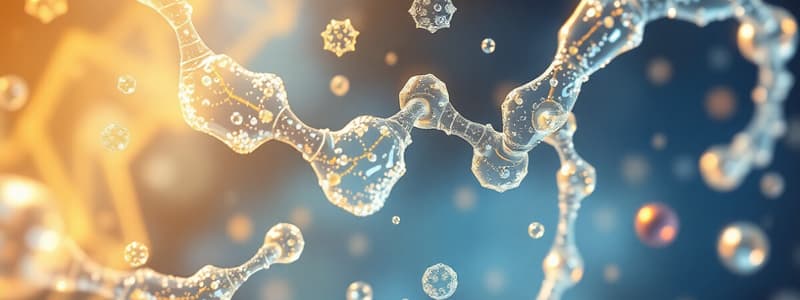Podcast
Questions and Answers
What is the primary role of carbohydrates in the body?
What is the primary role of carbohydrates in the body?
- To act as an essential energy source.
- To catalyze biochemical reactions.
- To transmit genetic information. (correct)
- To provide structural support in cells.
Which elements are the main components of carbohydrates?
Which elements are the main components of carbohydrates?
- Carbon, Hydrogen, Oxygen
- Sodium, Chlorine, Magnesium (correct)
- Iron, Zinc, Copper
- Nitrogen, Phosphorus, Potassium
How are carbohydrates classified based on their molecular complexity?
How are carbohydrates classified based on their molecular complexity?
- Simple, Complex
- Acids, Bases, Salts (correct)
- Organic, Inorganic
- Saturated, Unsaturated
Which of the following is a monosaccharide?
Which of the following is a monosaccharide?
What general formula represents a monosaccharide?
What general formula represents a monosaccharide?
What is the function of monosaccharides in the context of larger carbohydrates?
What is the function of monosaccharides in the context of larger carbohydrates?
Which of the following is the primary role of glucose in living organisms?
Which of the following is the primary role of glucose in living organisms?
Where is fructose primarily metabolized after absorption?
Where is fructose primarily metabolized after absorption?
What type of bond connects two monosaccharides to form a disaccharide?
What type of bond connects two monosaccharides to form a disaccharide?
Which process occurs when a disaccharide is formed from two monosaccharides?
Which process occurs when a disaccharide is formed from two monosaccharides?
What is the molecular formula of disaccharides?
What is the molecular formula of disaccharides?
Which disaccharide is composed of D-glucose and D-fructose?
Which disaccharide is composed of D-glucose and D-fructose?
What is the primary source of lactose?
What is the primary source of lactose?
Which of the following describes a polysaccharide?
Which of the following describes a polysaccharide?
What type of reaction is required to break down polysaccharides into monosaccharides?
What type of reaction is required to break down polysaccharides into monosaccharides?
Which of the following determines whether a polysaccharide is suitable for energy storage or structural support?
Which of the following determines whether a polysaccharide is suitable for energy storage or structural support?
Which polysaccharide serves as an energy storage form in plants?
Which polysaccharide serves as an energy storage form in plants?
Which polysaccharide is the equivalent of starch in animals, serving as a readily mobilized energy source?
Which polysaccharide is the equivalent of starch in animals, serving as a readily mobilized energy source?
Why can glycogen be metabolized more quickly than starch?
Why can glycogen be metabolized more quickly than starch?
What role does ribose play in genetic processes?
What role does ribose play in genetic processes?
Besides energy storage and structural components, what other biological processes involve saccharides?
Besides energy storage and structural components, what other biological processes involve saccharides?
How does the digestion rate differ between simple and complex carbohydrates?
How does the digestion rate differ between simple and complex carbohydrates?
What does 'yield' refer to in the context of carbohydrates and nutrition?
What does 'yield' refer to in the context of carbohydrates and nutrition?
What is the initial step in the metabolic catabolism of monosaccharides?
What is the initial step in the metabolic catabolism of monosaccharides?
What role do enzymes play in breaking down polysaccharides during glycolysis?
What role do enzymes play in breaking down polysaccharides during glycolysis?
How do 'processed foods' generally compare to 'unrefined foods' in terms of carbohydrate content?
How do 'processed foods' generally compare to 'unrefined foods' in terms of carbohydrate content?
How is dietary fiber different from other carbohydrates in terms of energy contribution?
How is dietary fiber different from other carbohydrates in terms of energy contribution?
What is the recommended daily allowance (RDA) of added sugar for adults?
What is the recommended daily allowance (RDA) of added sugar for adults?
What is the role of food manufacturers and food labeling in managing sugar consumption?
What is the role of food manufacturers and food labeling in managing sugar consumption?
In what part of the cell does glycolysis occur?
In what part of the cell does glycolysis occur?
Flashcards
What is a carbohydrate?
What is a carbohydrate?
Essential molecule in the body composed of C, H, and O atoms; also called saccharide.
What are monosaccharides?
What are monosaccharides?
The simplest carbohydrates that cannot be broken down into smaller units; general formula is (C•H₂O)n.
Functions of monosacharides?
Functions of monosacharides?
Fuel molecules and building blocks for nucleic acids; examples include glucose and fructose.
What is the role of glucose?
What is the role of glucose?
Signup and view all the flashcards
What is fructose?
What is fructose?
Signup and view all the flashcards
What are disaccharides?
What are disaccharides?
Signup and view all the flashcards
What is sucrose?
What is sucrose?
Signup and view all the flashcards
What is lactose?
What is lactose?
Signup and view all the flashcards
What are polysaccharides?
What are polysaccharides?
Signup and view all the flashcards
Functions of carbohydrates?
Functions of carbohydrates?
Signup and view all the flashcards
What is starch and glycogen?
What is starch and glycogen?
Signup and view all the flashcards
What is the role of polysaccharides?
What is the role of polysaccharides?
Signup and view all the flashcards
Simple vs Complex carbs?
Simple vs Complex carbs?
Signup and view all the flashcards
What is dietary fibre?
What is dietary fibre?
Signup and view all the flashcards
What is glycolysis?
What is glycolysis?
Signup and view all the flashcards
What is catabolism?
What is catabolism?
Signup and view all the flashcards
What are simple carbohydrates?
What are simple carbohydrates?
Signup and view all the flashcards
What are Complex Carbohydrates?
What are Complex Carbohydrates?
Signup and view all the flashcards
Risks of Hight Sugar?
Risks of Hight Sugar?
Signup and view all the flashcards
Carbohydrate caloric value?
Carbohydrate caloric value?
Signup and view all the flashcards
Study Notes
- Fundamentals of Science - Level 6 Certificate in Food Science and Technology.
- Carbohydrates are essential molecules in the body.
- They consist of carbon, hydrogen, and oxygen atoms.
- Carbohydrates, also known as saccharides include sugars, starch, and cellulose.
- They are divided into chemical groups with increasing molecular weight (MW).
Classification of Carbohydrates
- This includes monosaccharides, disaccharides, and polysaccharides.
Monosaccharides (Simple Sugars)
- Called the simplest carbohydrates because they cannot befurther reduced.
- They act as fuel molecules and building blocks for nucleic acids.
- Common examples are glucose and fructose.
- The general chemical formula is (C•H₂O)n.
- Those with three carbon atoms are called triose
- Four carbon atoms are called tetrose
- Five carbon atoms are called pentose.
- They are a major source of fuel for cellular metabolism; glucose being the most important.
Monosaccharides in Nature
- In plants, the equivalent to glycogen is starch.
- In animals, glucose is stored in a space-efficient form called polysaccharide (glycogen, in humans and animals).
- Glycogen is stored in liver and muscle cells.
- Fructose is found in fruit sugar and is metabolized in the liver, absorbed directly into the intestines during digestion.
Disaccharides
- Formed when two monosaccharides join together, e.g., sucrose and lactose.
- They are composed of two monosaccharide units bound together by a covalent glycosidic link, formed from a dehydration reaction (loss of H2O).
- The formation involves the loss of a hydrogen atom from one monosaccharide and a hydroxyl group from the other.
- Disaccharides have the formula C12H22O11.
- Sucrose is the most abundant disaccharide and is found in plants.
- Sucrose is composed of D-glucose and D-fructose, linked by a Glycosidic bond.
- Lactose is composed of D-galactose and D-glucose.
- Lactose is sourced from mammalian milk.
Polysaccharides
- Are polymeric and consist of long chains of monosaccharide units linked by glycosidic linkages.
- They can undergo hydrolysis to yield constituent monosaccharides.
- Polysaccharides can be linear or highly branched.
- Storage polysaccharides include starch and glycogen, differing in their storage methods.
- Structural polysaccharides include cellulose and chitin.
Functions of Carbohydrates
- Polysaccharides store energy (e.g., starch and glycogen) and serve as structural components in cells (cellulose in plants).
- The 5-carbon monosaccharide Ribose is important in genetic molecules (RNA and DNA).
- Saccharides play a role in the immune system, fertilization, disease prevention, and blood clotting and foetal development.
Polysaccharides Plants vs Animals
- In Plants: starch, a polymer of glucose, serves as a storage form.
- In Animals: glycogen, a more densely branched form offers animal storage.
- Glycogen's properties allow it to be metabolized more quickly and is essential in the active lives of moving animals.
Classifying Carbohydrates
- Carbohydrates are either simple or complex.
- Simple carbohydrates (e.g., fructose) can rapidly increase blood glucose levels.
- Complex carbohydrates (starches) can slowly increase blood glucose levels.
- The speed of digestion is determined by what else is consumed with the carbohydrate, how the food is prepared, inter-individual differences in metabolism, and the chemistry of the carbohydrate.
Carbohydrates and Nutrition
- Provide 3.87 calories of energy per gram of food, compared to fat which provides 9 calories per gram.
- Major metabolic pathways of monosaccharide catabolism are glycolysis and the citric acid cycle.
- In glycolysis, polysaccharides are cleaved into smaller monosaccharides by enzymes (glycoside hydrolase).
- Processed foods are associated with higher levels of carbohydrates (sugars).
- Unrefined foods have lower amounts of carbohydrates.
Dietary Fiber
- Indigestible carbohydrates not used as a source of energy.
- It's function is to maintain a healthy digestive system.
- Inadequate fibre intake can lead to significant increases in mortality (e.g., bowel cancer).
Nutrition cont.
- Increased sugar intake is linked to increased risk of heart disease, type 2 diabetes and some types of cancer.
- Natural sugars are not linked to health risks.
- Natural sugars also support fiber intake along with vitamins and minerals.
- Added sugars are the ones to limit, reduced sugar associated with improvements to weight and blood glucose levels.
- Adults are recommended a RDA of 30g of added sugar per day.
- Food manufacturers and labelling support more informed choices for consumers.
Glycolysis
- A metabolic pathway that converts glucose (C6H12O6) into pyruvate (three carbon) (CH3COCOO- + H+).
- The process releases energy, forming high-energy compounds: ATP and NADH.
- It is carried out by 10 enzyme-based catalysed reactions.
- Glycolysis is one method that cells use to produce energy.
- Most monosaccharides (fructose and galactose) can be converted to one intermediate molecule.
- The intermediate molecules can be used to form fatty acids, which then join to form fat.
- Glycolysis occurs in the cytosol (cytoplasm) of most organisms.
- It is an oxygen-independent metabolic pathway that does not use molecular oxygen.
- Glycolysis is found in nature = one of the most ancient metabolic pathways.
- The glycolysis pathway is separated into two phases: an energy-required phase (investment phase) where ATP is consumed and an energy-releasing phase where ATP is produced.
Studying That Suits You
Use AI to generate personalized quizzes and flashcards to suit your learning preferences.
Related Documents
Description
Explore carbohydrates, essential molecules composed of carbon, hydrogen, and oxygen. Learn about their classification into monosaccharides, disaccharides, and polysaccharides. Monosaccharides, like glucose and fructose, serve as fuel molecules and building blocks.




